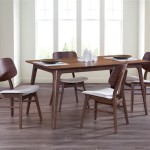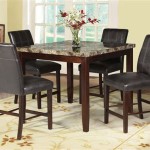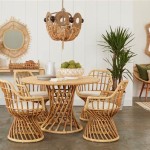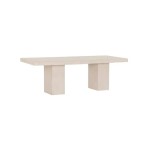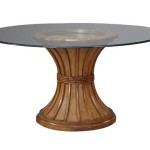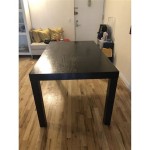How To Match Dining Chairs To Table
Selecting dining chairs that complement a dining table is a critical element in creating a cohesive and aesthetically pleasing dining space. The right pairing can elevate the entire room, fostering a welcoming atmosphere for meals and gatherings. Successfully matching dining chairs to a table involves careful consideration of several factors, encompassing style, material, size, and color. This article provides a comprehensive guide to navigating these aspects, enabling the creation of a harmonious and functional dining area.
Understanding Style Compatibility
The first step in matching dining chairs to a table lies in understanding stylistic compatibility. The chairs and table should share a similar aesthetic, avoiding jarring contrasts that disrupt the visual harmony of the room. Identifying the overarching style of the dining table is paramount before selecting accompanying chairs.
Traditional Dining Tables: Traditional dining tables often feature ornate detailing, rich wood finishes, and classic silhouettes. Common characteristics include cabriole legs, claw feet, and carved details. Matching these tables requires chairs that reflect similar characteristics. Upholstered chairs with button tufting, nailhead trim, or intricate wood frames are often suitable choices. Fabrics like velvet, damask, or linen in muted tones or classic patterns further enhance the traditional aesthetic. Avoid chairs with starkly modern lines or minimalist designs, as they will likely clash with the table's inherent formality.
Modern Dining Tables: Modern dining tables are characterized by clean lines, minimalist designs, and a focus on functionality. Materials commonly used include metal, glass, and engineered wood. Chairs that complement modern tables should exhibit similar simplicity. Options include chairs with sleek metal frames, molded plastic seats, or minimalist upholstered designs. Geometric shapes, neutral colors, and a lack of excessive ornamentation are hallmarks of modern chair styles. Avoid chairs with overly decorative elements or elaborate carvings, as these will detract from the table's streamlined aesthetic.
Rustic Dining Tables: Rustic dining tables embrace natural materials, weathered finishes, and a sense of informality. Common features include reclaimed wood, exposed joinery, and a less refined aesthetic. To complement a rustic table, consider chairs made from natural materials like wood, wicker, or rattan. Chairs with distressed finishes, simple designs, and a comfortable, inviting feel are ideal. Upholstery in natural fabrics like linen or burlap can further enhance the rustic charm. Avoid chairs with sleek, polished surfaces or overly formal designs, as these will appear out of place.
Transitional Dining Tables: Transitional dining tables blend elements of traditional and modern design, creating a balanced and versatile aesthetic. These tables often feature clean lines with subtle traditional details, providing flexibility when selecting chairs. Chairs that bridge the gap between traditional and modern styles are well-suited for transitional tables. Options include upholstered chairs with simple lines, chairs with a mix of wood and metal, or chairs that incorporate subtle traditional details like nailhead trim. The key is to maintain a balance between formality and informality, avoiding extremes in either direction.
Considering Material Harmony
Beyond style, the materials used in both the dining table and chairs play a crucial role in creating a cohesive look. The materials should complement each other, creating a sense of visual harmony and preventing clashes in texture or tone.
Wood Table and Wood Chairs: Matching a wood dining table with wood chairs is a classic and versatile approach. However, attention must be paid to the type of wood and its finish. Ideally, the wood types should be similar, or at least complementary. For example, a dark walnut table pairs well with chairs made from cherry or mahogany, while a light oak table might be better suited to chairs made from maple or birch. The finishes should also be considered. A high-gloss finish on the table might require equally polished chairs, while a matte finish would be better complemented by chairs with a similar texture. Avoid mixing drastically different wood types or finishes, as this can create a disjointed look.
Wood Table and Upholstered Chairs: Pairing a wood dining table with upholstered chairs offers a balance of comfort and style. The upholstery material should complement the wood's color and texture. For example, a dark wood table can be paired with chairs upholstered in light-colored linen or velvet, creating a sophisticated contrast. A lighter wood table might be better suited to chairs upholstered in darker fabrics or patterned materials. The style of the upholstery itself should also be considered. A smooth, modern fabric will complement a sleek wood table, while a more textured fabric like tweed or burlap will enhance a rustic wood table.
Glass Table and Metal Chairs: Glass dining tables often paired with metal chairs create a contemporary and minimalist aesthetic. The metal finish should complement the glass color and style. For example, a clear glass table can be paired with chairs that have a brushed stainless steel or chrome finish for a clean and modern look. A tinted glass table might be better suited to chairs with a powder-coated metal finish in a complementary color. The overall design of the chairs should be simple and understated, allowing the glass table to remain the focal point of the dining area.
Mixed Materials: Experimenting with mixed materials can create a unique and visually interesting dining space. However, caution is advised to ensure that the materials complement each other. For example, a wood table could be paired with chairs that have metal legs and upholstered seats. The key is to find a balance between the different materials, ensuring that no single material dominates the overall design. Color and texture play a crucial role in achieving this balance. A consistent color palette or a shared textural element can help to unify the disparate materials.
Considering Size and Proportion
Beyond style and material, the size and proportion of the dining chairs in relation to the table are crucial for both aesthetics and functionality. Chairs that are too large or too small can disrupt the visual balance of the room and make it uncomfortable to dine.
Chair Height: The most important factor to consider is the chair height in relation to the table height. Ideally, there should be approximately 10-12 inches of space between the seat of the chair and the underside of the table. This allows for comfortable legroom and prevents diners from feeling cramped. If the chairs are too low, diners will feel like they are reaching up to the table. If the chairs are too high, diners will have difficulty fitting their legs under the table. Before purchasing chairs, measure the height of the table and the seat height of the chairs to ensure a proper fit. Some chairs may have adjustable height options to accommodate different table heights.
Chair Width: The width of the chairs should also be considered, particularly in relation to the table's size and the number of chairs needed. Chairs that are too wide can overcrowd the table, making it difficult for diners to move comfortably. A general rule of thumb is to allow at least 24 inches of space per diner. This means that each chair should be no wider than 24 inches, and the table should be wide enough to accommodate the number of chairs needed. Also, consider the space needed for guests to pull out their chairs comfortably from the table.
Chair Depth: The depth of the chairs should be proportionate to the depth of the table. Chairs that are too deep can overwhelm the table, while chairs that are too shallow can appear insignificant. A general rule of thumb is to choose chairs with a depth that is approximately two-thirds of the table's depth. This creates a balanced and visually appealing look. For example, if the table is 48 inches deep, the chairs should be approximately 32 inches deep.
Chair Back Height: The height of the chair backs can also impact the overall aesthetic of the dining area. Chairs with high backs can create a more formal and imposing look, while chairs with low backs can create a more casual and relaxed atmosphere. The choice depends on the desired style and the overall proportions of the room. Consider the height of other furniture in the room, such as sideboards or artwork, when selecting chair back heights. Aim for a consistent scale and proportion throughout the dining area.

How To Master The Mismatched Dining Chair Trend

How To Mix And Match Dining Chairs Temple Webster

How To Mix And Match Dining Chairs Crate Barrel

How To Mix And Match Dining Chairs Modish Living

How To Master The Mismatched Dining Chair Trend

Mixing And Matching Dining Tables Chairs A Collected Home

How To Mix Dining Chairs And Tables Pass The Pretty Test

How To Mix Match Dining Chairs Plus 8 Beautiful Combos

Mismatched Dining Chairs How To Create Your Unique Look

How The Experts Mix And Match Dining Chairs

